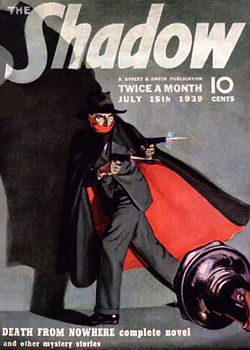Not many people are aware of the link between magic — I mean, the kind of illusions a stage magician performs — and writing, particularly fiction. The link is made explicit by the writers who find Henning Nelms’ book Magic and Showmanship: A Handbook for Conjurers to be full of good advice for storytelling as well as magic. And the link is embodied in Walter B. Gibson, who was born September 12, 1897, and was a successful writer as well as a working stage magician.
Gibson was born in Philadelphia, in the US, and after graduating from university began working for newspapers in Philadelphia as both a reporter and a crossword-puzzle constructor. By 1923 he was publishing articles about tricks and puzzles in Science and Invention magazine. A few years later he became the editor of another magazine, True Strange Stories. In addition to editing, he wrote his own stories, and after submitting some to Detective Story Magazine, he got his big break. It was a bit of a strange break, but a break nonetheless.
At the time, in 1928, radio dramas were popular, and one of the best was The Shadow. It was a detective story sponsored by the publisher Street & Street — which also published Detective Story Magazine. They wanted to extend The Shadow beyond radio dramas into printed stories for their magazine, and asked Gibson to do the writing. In the radio drama, The Shadow was simply a mysterious, unnamed narrator. But to be the main character in stories and novels, he needed to be fleshed out, and that’s what Gibson did. He created “Lamont Cranston,” a wealthy playboy with a secret identity (The Shadow) who, at night, fights crime. Yes, this is exactly the same conceit behind Batman, Green Hornet, and who knows how many other characters from the golden age of comics. But Gibson came up with it first.
The project was, to put it mildly, a success. The first Shadow story was published in April, 1931, and within six months there was a new quarterly magazine containing nothing but stories about The Shadow. They relaunched a new radio show, too, where The Shadow became more than just the narrator. A few months later, The Shadow magazine had increased its schedule from quarterly to monthly then twice monthly, and Gibson was writing all of it. For the magazine alone, he was writing the equivalent of 24 novels per year, and ended up writing at least 283 Shadow novels. Some wag has estimated that Gibson wrote more than 15,000,000 words about The Shadow. But you won’t see his name on the books; he used the pen name Maxwell Grant.
The Shadow became a whole franchise, with daily comic strips in newspapers, comic books, movies, and board games, and Gibson was involved with all of it. You wouldn’t think he had any time to spare, but evidently he did, because he also wrote more than a hundred books that weren’t about The Shadow. He wrote nonfiction books about magic, ESP, true crime, knots (yeah, I know, knots??), yoga, and hypnotism. He wrote at least five out of twelve novels in the Biff Brewster series of juvenile adventure stories. He was the ghostwriter for books on magic by magicians Harry Houdini, Howard Thurston, Harry Blackstone, Sr., and Joseph Dunninger. He wrote the novelization of a popular Preston Sturges screenplay, The Sin of Harold Diddlebock — or really he ghostwrote it, because it was published under the name of Harry Hershfield, who was a popular humorist who had been commissioned to write the novelization, but couldn’t get past the first chapter.
You might be thinking that Gibson never emerged from behind his typewriter, but in addition to writing, he also performed magic. He never became a famous headliner like Houdini or Blackstone, but his performances were in demand locally, and he invented at least one trick (Nickels to Dimes) that’s still performed nowadays. If you visit a magic shop (or, well, amazon.com) you can still buy it. Gibson also participated in Houdini’s seances (which were primarily ways to expose scams). After Houdini died, his wife held seances to try to contact Houdini’s spirit, since he had vowed to get in contact after death if there was really any way to do it. Gibson participated in those seances too, and eventually presided over them in the 1970s and 1980s. The Houdini Seances are still held annually, by the way; Houdini hasn’t yet attended. You can find out more about seances in Gibson’s book The Complete Illustrated Book of the Psychic Sciences, published in 1966. It even covers tasseography, which is telling fortunes by reading tea leaves.
Gibson has appeared as a character in a number of stories and novels, and at least one miniseries. He’s the main character in The Chinatown Death Cloud Peril, from 2006, in The Astounding, the Amazing, and the Unknown (2011), and The War of the Worlds Murder (2005).

